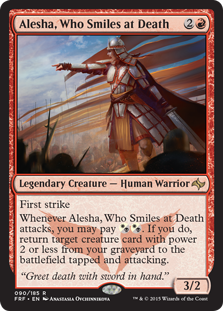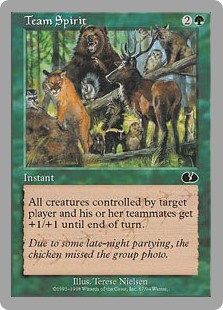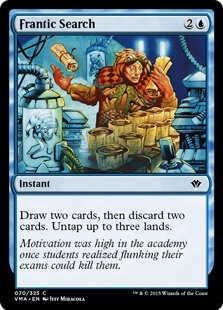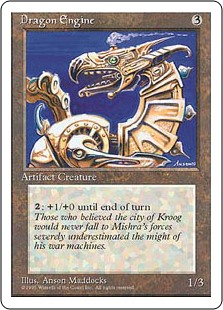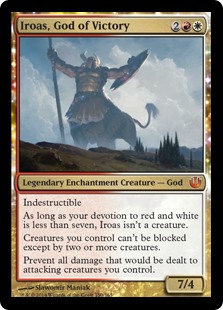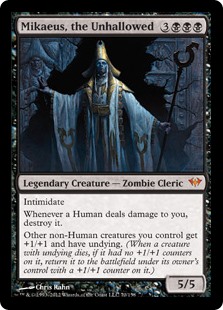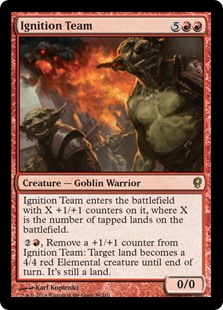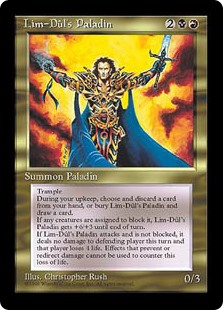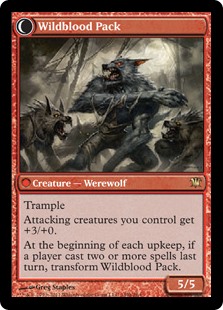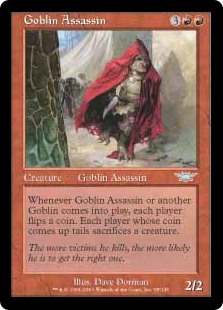Welcome back, fellow …Magician?
You know, it’s funny. Magic: the Gathering has been around for more than two decades, but in all that time, for all the myriad hours of playing, talking, and researching the game across countless individual experiences, the community has yet come up with a suitable nickname for game players.
I mean, there is the long-standing term ‘cardflopper’, but that’s mostly an (albeit aptly-named) pejorative. And while planeswalkers are the thematic intent of what you’re doing – something often forgotten about nowadays – it’s not exactly something players bandy about with pride…
But I digress. We’re here to talk about the game itself.
When we left off in last week’s intro to the article series, I had decided to embark on a mission that was part teaching tool into one method of building an EDH deck and part timed exercise that would force me to build a deck in a far more normalized time frame than I have done traditionally.
As I alluded to, building decks has never been my strong suit. Sit me down with a blank piece of paper with the intention of making a deck from scratch and I’ll probably stare at it for 15 minutes, jot down a handful of ideas, and then agonize over which cards I’d use in it for months. Literally. Likely by the end I’ll be in some sort of semi-catatonic stupor as I desperately try to finalize the last few slots, second guessing myself at every turn.
Want me to improve a deck, though, and I can do that six ways to Sunday.
Fortunately for you, and unfortunately for me, we’re focusing on the former in this case. In a much-desired case of attempting to break a pattern of behavior and to continue to grow as a player, it was decided that I would walk people through the process of how I do deck construction and that I would do it at a more accelerated pace than I’m traditionally comfortable with. At the onset, it was revealed that our Commander would be Alesha, Who Smiles At Death, a B/R/W Commander whose trick is bringing small creatures back from the abyss straight into combat, possibly to die and live again at her whim.
Alesha is a top-down style Commander selection with a very specialized focus in which to build around. In many ways, Alesha is a more restrictive and therefore more fair version of Kaalia of the Vast, as she’s less open-ended and requires more pieces to make her work than Kaalia itself.
However, that doesn’t mean Alesha can’t be abused something fierce. She can and often is, as even a cursory glance at deck builds online will likely show you. However, I’ve been avoiding looking at them, as part of my desire is to create the deck strictly from my own ideas, the input of those around me, and suggestions of viewers like you.
My intent from the start was to make Alesha a potent combat-style deck that can handle political situations, that isn’t easily broken, and that can be aggressive without being too punishing. Since I don’t generally gravitate towards combat-centric decks, Alesha seemed like an even greater challenge than my other options. Thus, the goal is to craft a deck whose primary function is outside my traditional play style but one that I won’t overcompensate with by going too mean in the other direction.
Moreover, the deck still has to function and play in a way that I’m going to enjoy. That is a central tenant to any deck you make, but it’s especially true in multiplayer games: make something you’re going to have fun with and that fits your own style. Magic is so rabidly successful in no small part because of how custom-tailored you can make a deck fit alongside your personal preferences. Take advantage of that.
This was largely the approach taken when I began digging through the initial list of creatures conjured up – some 350+ cards that either Alesha could return to the battlefield for some useful purpose or who could assist her in some capacity. This guideline created more than a few different avenues to consider, and I pondered over quite a few of them before the process began of whittling the list down to something far more manageable.
Of course, that doesn’t mean it was easy.
Making tough choices is a pretty standard thing when it comes to creating a Commander deck. A 99-card deck sounds like a lot at first, but once land is factored in, you only truly have 55-70 card slots to work with most of the time. As such, every selection matters. Whether that selection is made for optimization purposes, flavor, or any host of other reasons is immaterial. Cards don’t get added to an EDH deck on a whim; whatever your justification is, you have a reason it’s in there.
Part Two: Forming The Core
This brings us to the next phase of deck construction. As mentioned previously, I initially decided to focus on creatures because that’s what Alesha is mostly all about. In a week I have gone about the process of getting that megalith of a list down to 70. 70 cards may be close to twice the number of creatures that will ultimately end up in the deck, but it gives a much smaller pool of cards to work with. Admittedly, this approach of trimming cards out of a massive list bit by bit is hardly ideal from a time efficiency standpoint. The upshot, however, is that it can really help you fine-tune the concept of the deck you want right out of the gate, letting you distill it down like a refined cup of coffee.
When going through such a list, setting up some criteria for what you want is essential. This can be anything from combo and synergy pieces to subthemes and flavor. I conceived and went through many thought processes for Alesha, and a handful of the major ones stuck. These included:
- Taking advantage of being small in the graveyard but get larger on the battlefield
- Useful Enter The Battlefield or death triggers
- Creatures that punish you for blocking and/or not blocking
- Sacrifice or discard abilities that fuel creatures in your graveyard
- Creatures that boost stats or benefit from attacking but don’t have “when Cardname attacks” triggers
- Creature types like Slivers or Allies who benefit from having others on the battlefield
- Utilizing ways to offset many creatures being inherently small, with abilities like flying, protection, first strike, double strike and deathtouch
- Redundant ways besides Alesha for getting creatures back
- Limiting the number of ways Alesha can simply break things wide open
Over the course of paring cards down, other ideas came and went as well. Some of these led to new areas of consideration, while others petered out. This is natural, expected, and will happen with this sort of process.
What follows, then, is the heavily trimmed list of Alesha creatures. It should be noted, though, that such a list is hardly exclusive or final yet. It’s entirely possible that as some cards go out, others will be added in. It’s all part of the process. Nevertheless, I thought it would be useful to examine some of the cards and why they were chosen to stay over others.
The first thing I did was heavily limit the number of creatures in the list that were too large for Alesha to bring back. Using her triggered ability is the cornerstone of the deck, and the more creatures outside of that range, the less of them work to that end. This is why of the final 70, only 13 are of power three or greater. These include:
- Adarkar Valkyrie: A flyer that can either resurrect your own creature or one of an opponent.
- Athreos, God of Passage: Lets you get creatures back into your hand instead of the graveyard when they die. Since many creatures should be cheap, casting them again shouldn’t be challenging.
- Boltwing Marauder: Another sizable flyer that buffs when a creature enters the battlefield…like during combat for instance.
- Deathbringer Thoctar: A 1/1 hoser who also gets larger whenever creatures die.
- Flayer of the Hatebound: This lets you deal damage to a creature or player whenever a creature of yours is reanimated. Useful when the creature is a 2/2, and deadly when it comes out as a 10/10.
- Grim Haruspex: Card draw whenever a creature dies. Since Alesha’s creatures will probably die often, it seemed like a good idea.
- Iroas, God of Victory: Gives your creatures Menace and prevents damage while being on offense. Both play right into Alesha’s combat mindset.
- Mikaeus, the Unhallowed: Another means of reanimating your creatures, although unlike many on this list it ironically won’t work with Alesha herself since she’s Human. Mikaeus is easily abused though, so deciding to keep him meant immediately scrapping a few other creatures such as Triskelion. Murderous Redcap survived, and so in turn I’ll have to be mindful of easily abusable sac engines.
- Ogre Battledriver: Another way to buff creatures when they return straight to combat from the battlefield or if played from my hand.
- Ogre Slumlord: Another means of taking advantage of the inevitable creature churn that will happen with Alesha’s creatures dying regularly while simultaneously adding defensive options.
- Reveillark: An easy choice, as it can return any creatures to the battlefield but those on this list.
- Sepulchral Primordial: A widespread mass reanimation option with Intimidate to boot.
- Sun Titan: Yet another reanimation option for many of the smaller permanents in the deck.
As for the remaining creatures, and why some of them made the first cut, we have to explore how I approached each facet. For starters, let’s look at our second-wave finalists:
Alesha's Glorious 57
Now let’s compare these to my initial goals and see how they shaped up:
Small In Graveyard, Big On Board
This heavy-hitters list was the quickest to compile and is also one of the easier ones to abuse. This includes many 0/0 creatures that come in with counters or get static buffs while on the battlefield. Most */* creatures don’t work for Alesha, as their power and toughness are usually set no matter what zone they’re in, so most of them weren’t even included in the initial list.
In a fun example of rules maneuvering, however, */* creatures that have an undefined quality (i.e. those set by having to make a choice when they’re played or entering the battlefield) are the exception. This is why I ended up with cards like Custodi Soulbinders, Entropic Specter, Ignition Team, and Sewer Nemesis.
Entering Or Leaving Triggers
I like having options in my decks, and in the current era of Magic, creatures with spell-like triggers to them are all the rage. In a sad case of “if you can’t beat ’em, join ’em”, I decided to take advantage of a wide variety of card effects. A lot of these cater to my personal preferences, but in general I tried to focus on things that will give me some kind of card advantage (Anarchist, Mindclaw Shaman), mana ramp (Burnished Hart) – and both in the case of Solemn Simulacrum – as well as card removal (Duergar Hedge-Mage, Duplicant, Murderous Redcap) and board control (Entomber Exarch, Knight-Captain of Eos, Shrieking Mogg ). Karmic Guide is also incredibly useful, but potentially dangerous as well. I’m fully aware how it and Reveillark can fuel multiple engines when paired together in the same deck, but for the time being it’s an exception I decided to make in this case.
On the other hand, one area that did fizzle out was that I ended up going with far fewer death-based triggers than originally planned, with the two real notable exceptions of False Prophet – which is both hilarious and scary – and Liliana, Heretical Healer, which both gives me zombies and whose planeswalker side aids the deck nicely.
Punishment No Matter What
When I first started compiling Alesha, I had a firm ‘damned if you do, damned if you don’t’ concept in mind. The idea was that I’d focus on attacking you with creatures that will punish you if you do block and punish you if you don’t. This too largely fell by the wayside in the end, and I decided on going a more combat damage approach. I do have some concerns about people simply blocking some of my smaller creatures in the end, so we’ll have to keep an eye on how to fix that.
That said, there were a few holdovers from this idea, including Blinding Angel, Drana, Liberator of Malakir, and Raving Dead – who, while random when attacking normally can be directed if Alesha-fied to devastating effect. He’s a zombie-infused Quietus Spike.
Oh, and then there’s Lim-Dul’s Paladin, which is a personal favorite here. This card is so bizarre and so terrific in this deck on multiple levels. It’s a shame that such a card would never be printed today, but I’m quite happy to put this head-scratcher of a card in, at least for now.
Sacrifice And Discards
For all of her trussed up abilities, Alesha really is effectively a highly restrictive reanimation deck. To that end she needs creatures in her graveyard to fully take advantage of her abilities. How we get this will vary, but sacrificing cards and discarding ones you don’t want to actually pay for are key. This is why you see card choices such as Flesh Carver, Mindless Automaton, and Pack Rat. Transmute also works well here as a twofer in the case of Dimir House Guard and Netherborn Phalanx, allowing you to tutor for specific cards while also getting useful reanimation fodder into your graveyard.
I hadn’t thought about it much early on, but over time I realized self-milling is also an option, as seen with Sewer Nemesis and Undercity Informer. There’s more room to explore here I feel as well, even if it is more of a Blue thing.
Combat Assistance
This is where I ultimately focused a lot of my attention, as a browse through the list will reveal. There aren’t a lot of strict static buffs like Instigator Gang that showed up on creatures, but it likely will be something to shoot for when fleshing out the deck. However, there are plenty of examples of creatures brandishing useful combat and evasion abilities like Flying (Herald of Leshrac, Vampire Nighthawk), Fear (Guiltfeeder), Protection (Mirrodin Crusader), First/Double Strike (Archetype of Courage, Markov Blademaster, Silverblade Paladin, and Deathtouch (Archetype of Finality).
I didn’t bother with Vigilance creatures since most will be coming in tapped and attacking. That said, finding ways to untap them may be essential to survival in the long run. Alesha on the offensive is likely to elicit some responses, and the last thing I’ll want is to have nothing held in reserve.
Creature Subthemes
There were a number of subtheme considerations made throughout the winnowing of the initial list, including Goblins, Slivers, Allies, and even Zombies. In the end, however, it was determined that a few offshoot combo pairings here and there couldn’t justify keeping one card solely to keep another, and almost all of the subthemes were cut entirely. The only real holdovers on this ended up being Necrotic Sliver and Siege-Gang Commander. For obvious reasons.
Keeping Alesha Alive
Aside from finding ways of preventing Alesha from taking the journey back to the Command Zone regularly, it proved difficult finding this angle with the smaller creatures and is why several of the large creature inclusions all revolve around reanimating creatures – should I choose to let Alesha hit the graveyard herself.
Curtailing Alesha’s Power
Lastly, I feel I’ve largely curtailed some of the most egregious ways Alesha can be abused, but certainly not all. The creature list presented here has at least two infinite combo if it has access to a reliable sac engine and / or mana, and it’s something I’m going to have to consider going forward. The deck would hardly revolve around them, but is that enough to justify their presence to me? I’ll need to think on that more. This also happens, and it’s to be expected while building a complex deck. One thing I did at least was ensure that most of the discard and sac mechanics thus far involved low mana costs of some kind to ensure I couldn’t simply trip into an infinite win combo. It still might happen, but every little bit helps, right?
Now that I have these creatures in hand, the next step is determining how to make these (mostly) smaller creatures larger and scarier when on the battlefield. Aside from an occasional spell or two, this means propping them up with Artifacts and Enchantments. Three of the cards I have set aside as my “Special Slot 71s” all play into this, being Auriok Salvagers, Stoneforge Mystic, and Totem-Guide Hartebeast to see which way the winds blow. I have to decide whether I want to focus my attention on Auras, Equipment or to largely forgo both and try for more Glorious Anthem-style cards. Once we have those in place, we’ll then be able to revisit the creature list and start stripping stuff out further. But first, to the Gatherer-cave!
![]()
Want to talk shop about Building the Dragon Engine, including the cards mentioned? Tell us over on our social media!
Do you have a particular Commander card to suggest for us to shine a future Spotlight on? You can send suggestions to ryan@cardboardrepublic.com

